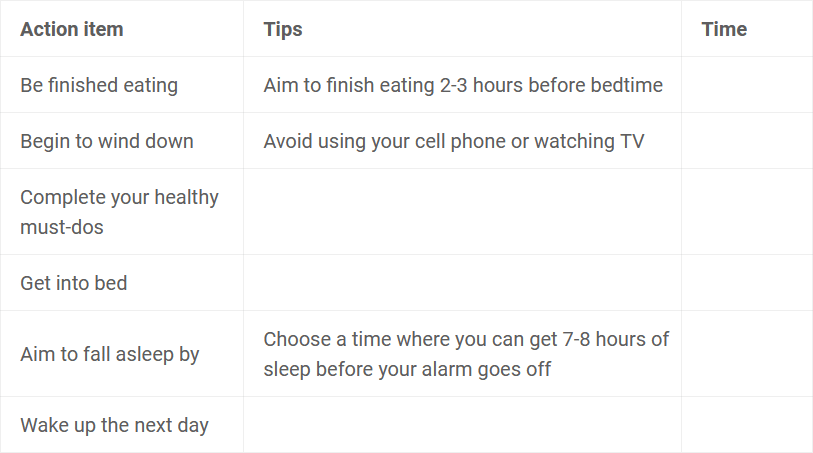Getting a good night’s sleep doesn’t start at bedtime. It’s actually dependent on the choices you make throughout much of your day—which means you need to be thinking about, and planning for, good sleep well before your head hits the pillow.
Use this article to guide you in creating a sleep plan. Get a printer-friendly PDF version here–save it to your computer and either type directly into the editable fields, or print it out and write on it.
A few things to keep in mind before you start your plan:
- By having a sleep routine and doing the same activities each night, you can train your body and mind to get ready for sleep.
- 7 to 8 hours is the ideal amount of sleep for most adults, and it’s best to stick to the same schedule every day of the week, including on weekends.
- Try to finish eating 2-3 hours before your bedtime, and avoid going to bed hungry or overly full.
- Stop consuming caffeinated beverages or food 6 to 8 hours before your bedtime
- Take steps to make your bedroom more sleep-friendly so that you’ll feel comfortable and relaxed.
- Stress can affect the quality of your sleep. Find ways to address your stress before bedtime so that your mind is quiet and calm when you get into bed.
Create your sleep plan
By doing the same activities each night, you can train your body and mind to get ready for sleep. Your sleep plan includes three sections: Your wind-down toolbox, your healthy must-dos, and your evening routine. Filling out all three sections will help you be fully prepared not just for a good night’s sleep, but also a good tomorrow!
Step 1: Build your nighttime wind-down toolbox
As it gets closer to bedtime, avoid doing stimulating activities that can disrupt your ability to get to sleep and replace them with activities that allow your brain and body to relax. We’ve given you a few ideas to get started. Circle or highlight the activities on the right that you want to try, and write any of your own ideas below.

What other activities can you do to wind down?
Step 2: Make a little time for healthy must-dos
These aren’t the most exciting habits and activities, but building them into your routine can help you stay healthy and reduce your stress.
- Cleanliness and hygiene: Brushing and flossing your teeth; washing your face
- Household activities: Do you need to run the dishwasher, take out the trash, etc.?
- Preparation activities: Make sure your alarm is set for tomorrow and do anything else that makes you feel prepared, like jotting down a quick to-do list, choosing tomorrow’s outfit, or packing your lunch
- Caring for others: If you care for children, pets, or other family members, is there anything you need to do for them before you get ready for bed, like let the dog out or make sure your kids did their homework?
What other things do you need to make sure are done before bed?
Step 3: Create your evening routine
Having a written plan in place can help you stay on track with your evening routine. Write down the times you will do each aspect of your routine.
Tip: If you’re finding it challenging to stay on schedule, consider setting a timer in case you need a little nudge to remember that an action item is coming up!
What time will you…?

One final tip: The first version of your sleep plan might not be the final version of your plan—and that’s okay! If you find that something isn’t working quite right for you—for instance, if you need to allot more time for certain activities, or you discover that you function better on slightly more or slightly less sleep than you’d been aiming for—adjust the plan. Your sleep plan can evolve over time as your needs or schedule change. The most important thing is that you have a plan that works for you!



